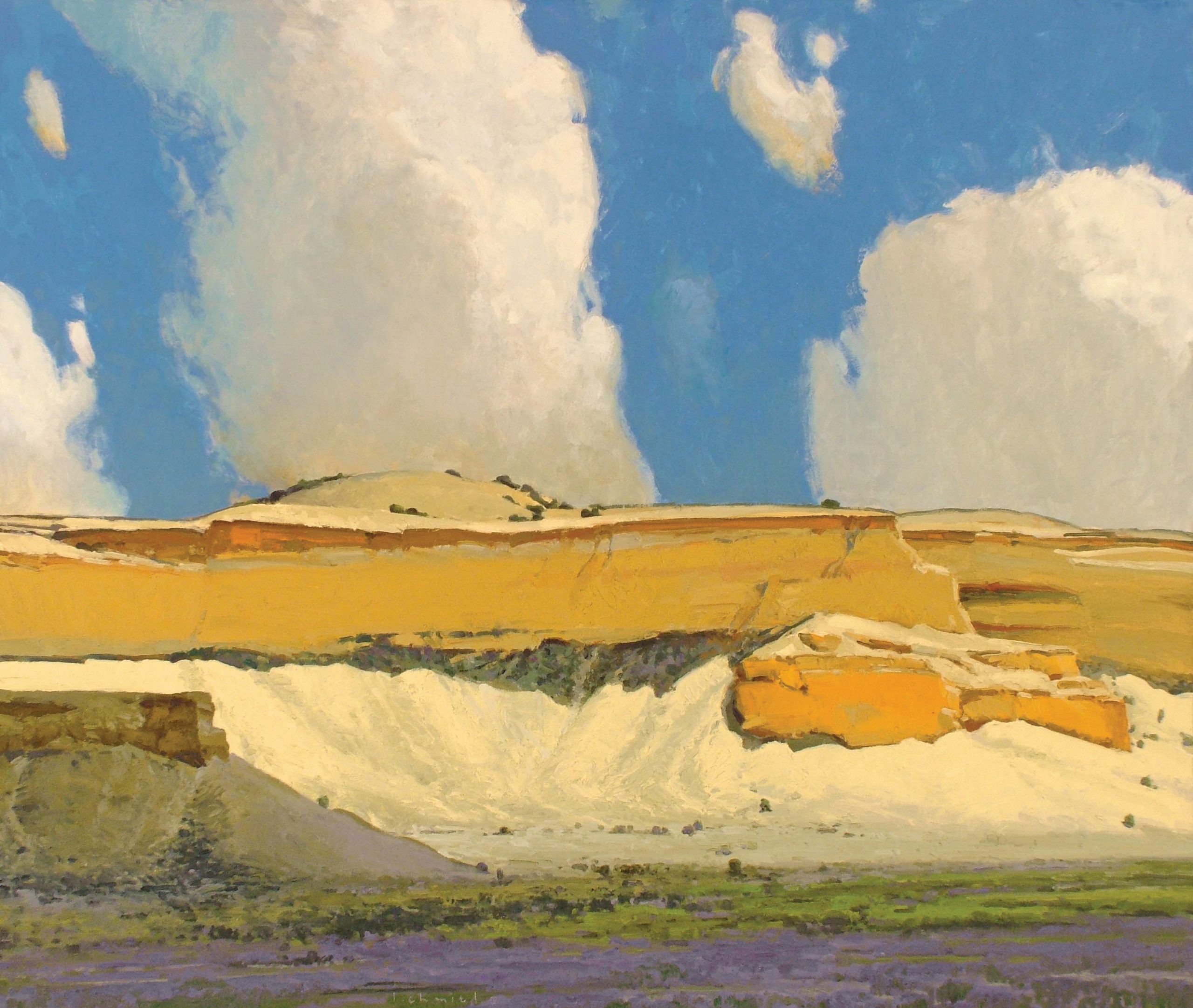
06 Sep Len Chmiel: An Artists’ Artist
After 53 years as a professional fine artist, Len Chmiel hopes he can paint until he can’t hold a brush. Curiosity is a constant companion for the 82 year old, which allows him to see every landscape as if for the first time. Living atop a mesa in Western Colorado on 18 acres, he says, “Looking out my kitchen window, I see a range of mountains — that scene feels new to me every day. And it never gets boring, never gets boring! It’s a wonderful feeling; I feel fortunate that this artist’s life chose me. I did not decide to become an artist. I fell into it, and I followed it — that led me to an incredible life.”
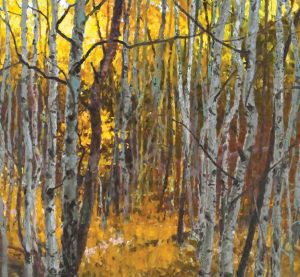
Simple Pleasures | Oil on Canvas | 26 x 28 inches
Chmiel’s paintings have appeared in many premier museum exhibitions and events celebrating Western art, including Masters of the American West at the Autry Museum in Los Angeles, Prix de West at the National Cowboy & Western Heritage Museum, the Coors Western Art Exhibit & Sale, and Western Visions at the National Museum of Wildlife Art, among others. In 2016, the Steamboat Art Museum in Steamboat Springs, Colorado, honored Chmiel with a 45-year retrospective. However, amid his many accolades, Chmiel’s 16 artists’ choice awards stand out. “It’s not something I aspire to,” he says, “but it’s the most important award one could want because it’s your peers saying this guy’s work is deserving.”
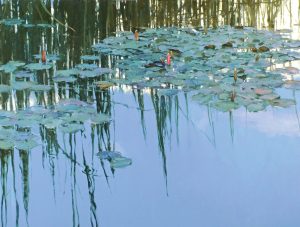
Suspended Reality | Oil on Canvas | 36 x 48 inches
Evident from these artists’ choice awards is that Chmiel is an “artists’ artist.” Says painter Ralph Oberg, “We’re all at different levels of understanding and skills, and we each have our own point of view as to what’s good. Every now and then, there are a few artists that everybody agrees are the best because the more you know, the more you understand how good they are. All of us who have spent our lives around Western art know that 16 artists’ choice awards are the most coveted. Chmiel and George Carlson have cornered the market on that because their skills are so unique and personal.”
In 2009, the Thunderbird Foundation for the Arts, the studio and home of the famed Western artist Maynard Dixon, awarded Chmiel’s work Best of Show in their invitational. Director Susan Bingham says many artists comment on Chmiel’s abilities while looking with awe at his paintings. “Artists, when speaking of Len Chmiel, do so in an admiring way, perhaps because he takes risks and gets away with it. Some artists do the same thing over and over, but Chmiel will take on different subjects, and nothing is ever the same. Every painting of his is an original; he is not derivative of anyone or any style,” Bingham says. “One example is how he approaches every painting as a new experience; his palette can change from high key to saturated color or another combination; he allows the subject matter to dictate that. … I think of musicians that can play many styles — jazz, classical, and popular. Those who have a wide range of knowledge about each one that enables them to do it well remind me of Len Chmiel — he can do the same with art.”
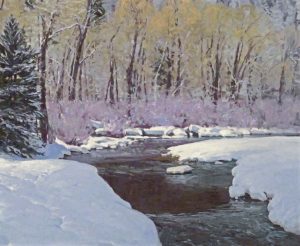
The West I know, Introducing Spring, Crystal River, CO | Oil on Canvas | 25 x 32 inches
Chmiel says the idea of being an artists’ artist is “just who I am to those who consider me as that.” In his perspective, it’s an opportunity to be an artist and an honor that people recognize his work on the wall and want it to hang there. He says that artists must know who they are and believe in themselves because this comes out in their paintings.
“If I have to make a definition of art, I’d say it has to reflect your personality. Personally, I do work that matters to me. I try to bring my version of beauty to the work,” Chmiel says. “I’m not interested in a specific genre or style, nor am I interested in doing the same thing over and over just because it’s commercially successful. I believe art is a direct reflection of who we, as individual artists, are; that’s why you have to know who you are as an artist.”
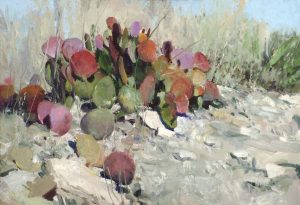
Prickly Pear Portrait | Oil on Canvas | 12 x 18 inches
Painter Dan Young shares what makes Chmiel’s work exceptional in his eyes. He and Chmiel often paint alongside one another outdoors, and they recently had a shared exhibit at Ann Korologos Gallery in Basalt, Colorado. He admires Chmiel’s reflective process when it comes to his creativity.
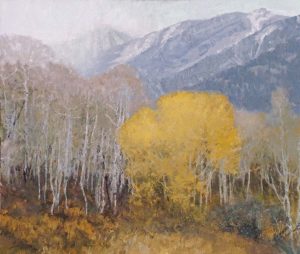
Spotlight, Center Stage | Oil on Canvas | 20 x 24 inches
“Chmiel cannot be pigeonholed because he paints everything at a remarkable skill level,” says Young. “He’s such a great designer, and he is definitely a thinker; he analyzes every scene that he’s considering for a painting. He’s not about trying to copy what’s in front of him; instead, that’s his inspiration. He notes things in his head — that can go on for 15 minutes or more — and then he creates a beautiful masterpiece.
“He’s known as a landscape Western artist,” Young continues, “but he paints whatever his intuition tells him to, and he doesn’t care if it sells. And it does sell, but that’s not the reason why he painted it. Chmiel paints because he sees a painting. Artists appreciate that.”
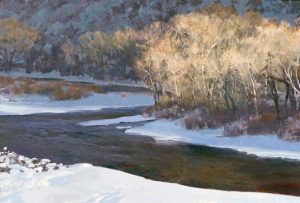
Turn of Events | Oil on Canvas | 24 x 35 inches
Often, the painting Chmiel sees is not the one other artists readily see. “The landscape is what I’m doing more than anything else; I look at it as the plants and topography are the cosmetic part of the spiritual, the part you can’t see; beneath it causes what’s on the surface. I look at what I’m seeing and say, ‘Yes, beautiful. It describes the soil, the climate, but why is it happening?’ I’m trying to get at the why, the general immaterial reach through the landscape,” Chmiel says.
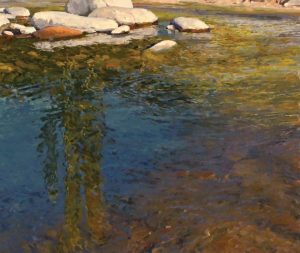
The West I Know, Double Jeopardy, AZ | Oil on Canvas | 34 x 40 inches
Cristy Maltese, a visual development artist for Disney Studios in Burbank, California, sees this idea in the artist’s work as well, saying “Chmiel’s subject matter is never the actual painting; rather the painting is always an unassuming door to another world, the real subject, which unfolds wider and deeper the longer you gaze.”
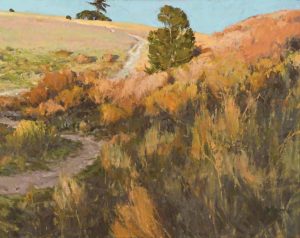
Trail to the View | Oil on Canvas | 23 x 29 inches
George Carlson, a close friend of Chmiel and another artist who often receives artists’ choice awards, admires his work. He speaks of the painting process that he and Chmiel experience: “We as artists are keeping a journal — a visual journal that allows life’s experiences to affect one in an emotional, physical, or mental way; it’s how a scene looks that does it,” he says. “Sometimes, Chmiel will do a commonplace scene, but in a way that makes it magical, where most artists would walk right by. He keeps his personal visual journal interesting and with new entries.
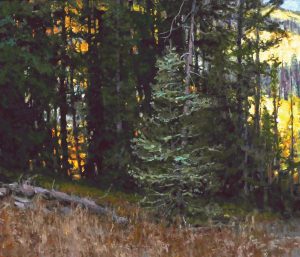
Natural Succession | Oil on Canvas | 20 x 24 inches
“As a polymath, Chmiel has an understanding about many things, including gardening, cooking, wine-making, hunting, and fishing. He has this wonderful openness and awareness that is extremely creative. He’ll think, how do I make this painting more asymmetrical? And he’ll hold it together as a great design while pushing it a little further than others would.
“The bottom line is: I have such respect for him. I trust him as a friend, and I trust him as an artist. When you have that, it can’t get any better,” Carlson concludes.
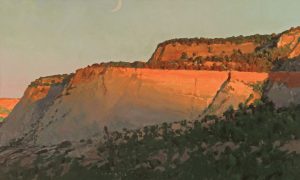
As the Details Emerge | Oil on Canvas | 24 x 40 inches
Chmiel looks forward to the things that make his life enjoyable — painting on location and working in his studio. When he’s not painting, he devotes his life to being self-sustaining by growing and hunting his own food. He also takes pride in preparing and serving these foods with wine from his vineyard. At home on a mesa, he established a pond, garden, and vineyard. There’s a 4-acre pasture for deer, elk, bobcats, coyotes, and turkeys, and the occasional mountain lion and black bear pass through.
“It’s the best life!” he declares.
Chmiel is represented by Maxwell Alexander Gallery in Pasadena, California; Simpson Gallagher Gallery in Cody, Wyoming; and Ann Korologos Gallery in Basalt, Colorado. Published in 2012, the book Len Chmiel: An Authentic Nature by Amy Scott covers 40 years of his painting career.






No Comments